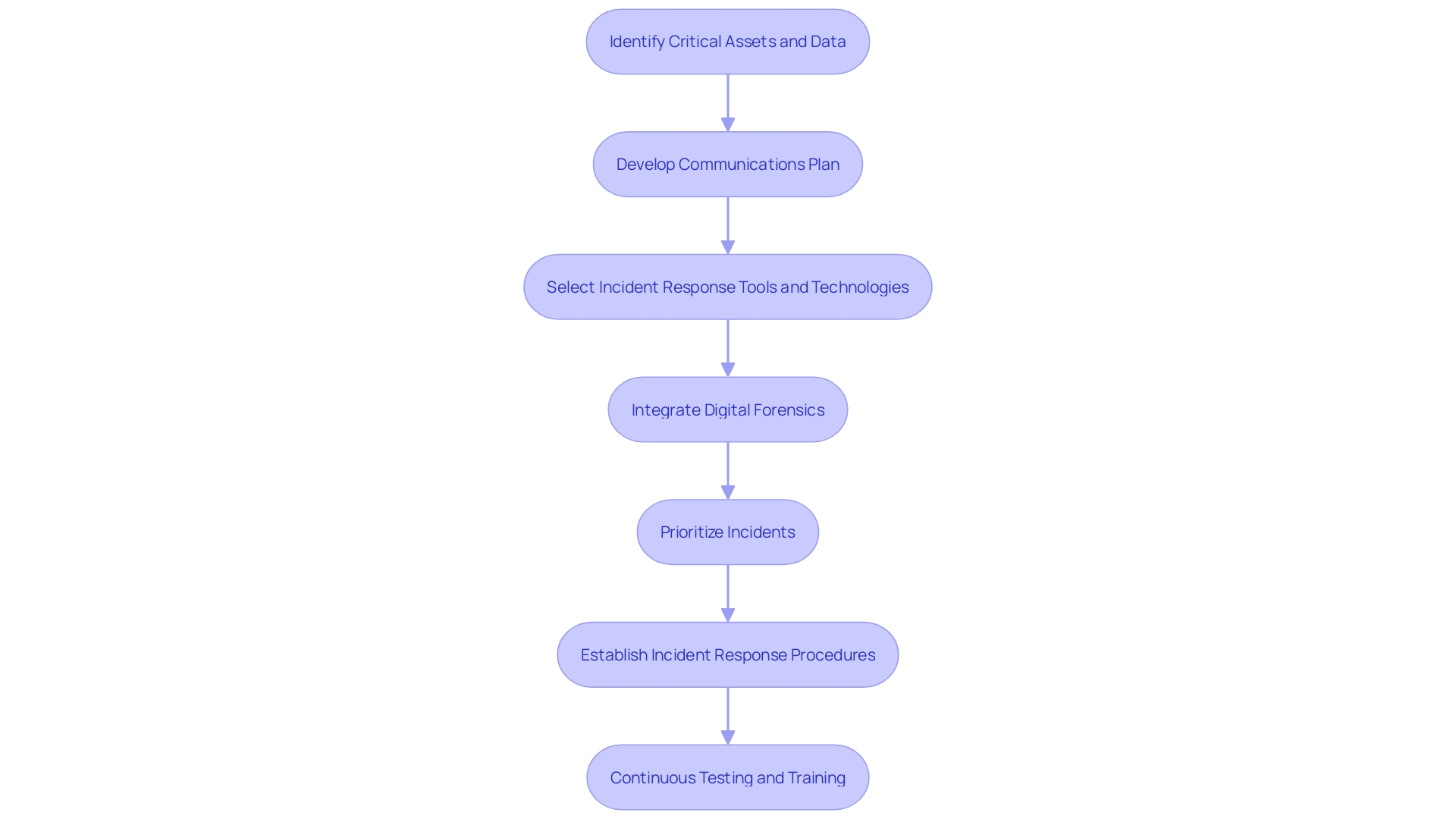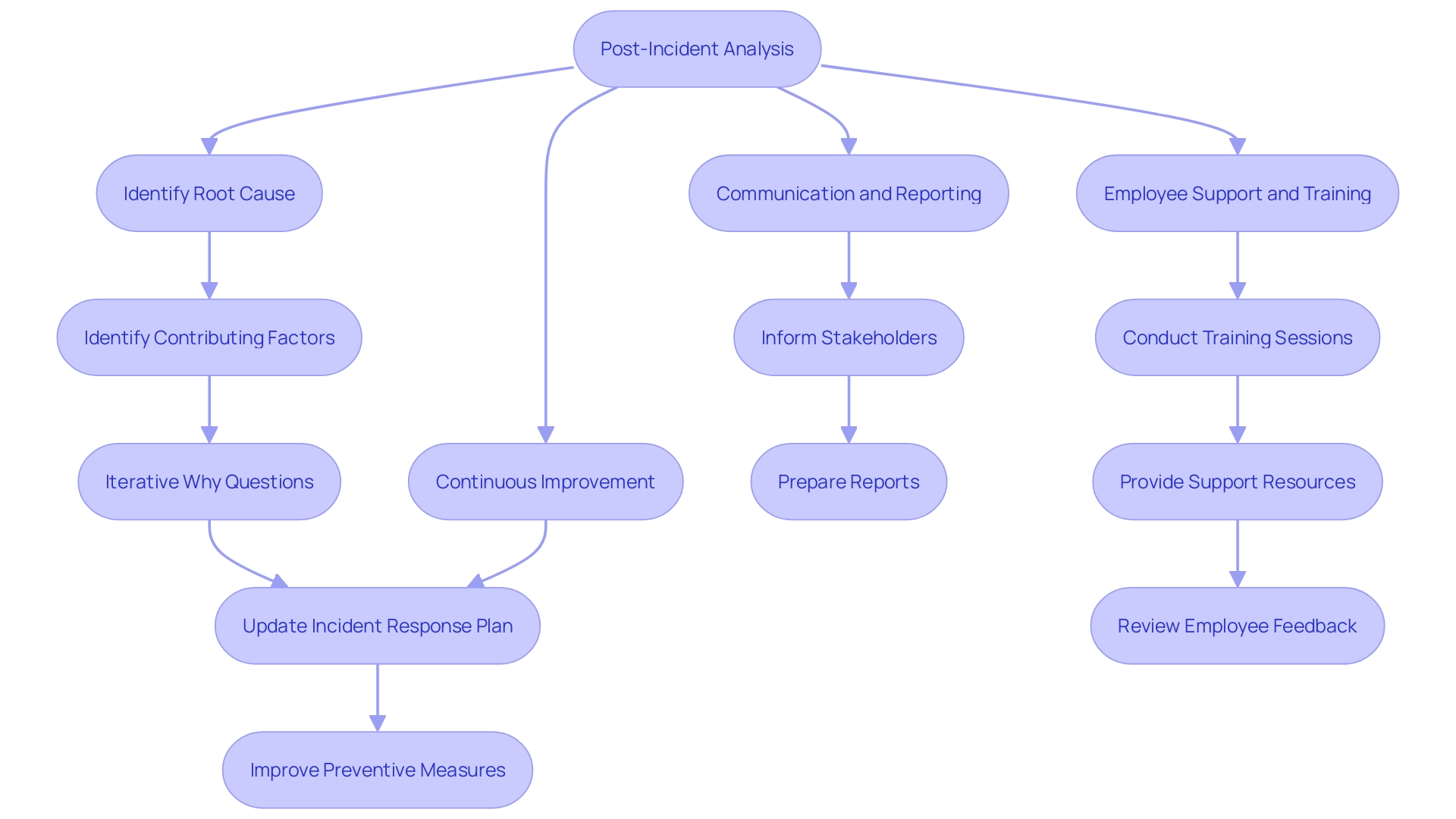Introduction
In today's interconnected technological landscape, incident response plays a crucial role in safeguarding organizations from cyber threats. It goes beyond immediate actions and encompasses a meticulously crafted strategy to identify, manage, and neutralize security incidents. By creating an incident response plan and establishing an Incident Response Team, organizations can effectively detect, respond to, and recover from incidents.
A key aspect of incident response is the ability to scrutinize contributing factors and root causes, such as configuration drift or code changes, to prevent future occurrences. The importance of a robust incident management workflow is highlighted by recent events, where coordination and strategic measures were essential to preserving public safety and security. Incident response is a continuous cycle, requiring organizations to gather evidence, learn from past incidents, and regularly test and refine their plans.
Ultimately, incident response is a pivotal element of an organization's security posture, ensuring the integrity of IT systems and services in today's threat landscape.
What is Incident Response?
Incident response transcends the immediate actions taken to combat cyber threats. It is a meticulously crafted strategy that involves identifying, managing, and neutralizing security incidents to minimize their impact and prevent future occurrences. The incident response plan is a comprehensive document that outlines the protocols for detecting, responding to, and recovering from these incidents. It includes the creation of an Incident Response Team, a group dedicated to managing the incident lifecycle—from detection through to remediation.
Key to an effective incident response is the ability to scrutinize contributing factors and root causes. For instance, a scenario like configuration drift—where a web server's settings diverge from established standards due to unauthorized modifications—can significantly amplify the impact of a security incident. This, coupled with other factors such as code changes or external service issues, necessitates a deeper inquiry into why these elements were present and why existing preventive measures failed to intercept them.
The importance of a robust incident management workflow cannot be overstated in today's interconnected technological landscape. It is the backbone that supports organizations in swiftly rebounding from disruptions while maintaining operational continuity. This process is dynamic, encompassing the identification, assessment, and resolution of incidents, ensuring that normal business activities can resume with minimal delay.
Recent events highlight the critical nature of an effective incident response. For example, when the 999 emergency system experienced an unprecedented technical fault, the subsequent review emphasized the necessity of coordination among all partners—BT, Emergency Authorities, and the government—to preserve public safety and ensure resilient access to emergency services.
Moreover, during a national County Lines intensification week, Police Scotland utilized strategic incident response measures, including the proposed introduction of CCTV systems to aid in locating vulnerable individuals and expediting investigations.
The journey of incident response is a continuous cycle, and part two of our series delves into the latter stages—Case Tracking and Remediation. Here, we explore the significance of diligently gathering evidence, organizing information, and learning from past incidents to enhance future response efforts. The effectiveness of incident response is further underscored by the recommendation for regular testing and refinement of the plan to ensure readiness when real incidents occur.
In conclusion, incident response is a pivotal element of an organization's security posture, helping to navigate the complexities of today's threat landscape and safeguarding the integrity of IT systems and services.

Importance of Incident Response in Cybersecurity
Effective incident response (IR) is a multifaceted discipline, essential for safeguarding an organization's cybersecurity posture. It encompasses a spectrum of activities such as detection, analysis, containment, eradication, recovery, and post-incident analysis. The primary objective is to limit the ramifications of security incidents, swiftly restore normal operations, and prevent recurrences. This proactive approach is evidenced by a recent AWS incident, where an unauthorized support case to increase SES sending limits was identified and acted upon. The malicious activity, spread over a month, was categorized into three phases using the MITER ATT&CK framework, highlighting the importance of understanding adversarial tactics for robust IR.
A robust IR plan is a documented strategy outlining procedures for each phase of incident response. Clarity and precision in language are vital, particularly when distinguishing between terms like 'event,' 'alert,' and 'incident,' to avoid ambiguity and ensure effective communication. The evolution of IR practices has been pivotal, with the formation of Computer Emergency Response Teams (CERTs) in the 1980s marking a significant milestone in establishing systematic approaches to cyber threats.
Recent analytics from January to July 2023, where ninety-five billion events were scrutinized, demonstrate the critical role of AI in detection. Out of the events examined, 0.1% were deemed 'alarms,' indicating potential malicious activity. Only a fraction of these alarms necessitated further investigation, illustrating the selective nature of IR processes. The Barracuda report from the first half of 2023 underscores Ai's value in both detecting and analyzing threats, showcasing the advanced capabilities available to organizations today.
The significance of testing and refining IR processes is paramount. Regularly evaluating your IR plan against real-world scenarios ensures readiness and reveals areas for improvement. By breaking down and testing critical processes, organizations can fortify their defenses and prepare for swift containment actions without disrupting production environments.
In summary, incident response is a critical function for maintaining cybersecurity, ensuring early detection and decisive action to mitigate threats. By learning from past incidents, like the transformative event for MITRE fifteen years ago, organizations can adapt and evolve their IR strategies, ultimately enhancing their security and resilience.
Key Components of an Incident Response Plan
A robust Incident Response (IR) Plan is an indispensable component of any cybersecurity strategy, serving as a blueprint for effectively managing and mitigating security incidents. At its core, the plan should encompass:
-
Incident Response Team: This team is the backbone of the IR process, charged with the critical task of security incident management. Their diverse skill set and preparedness are essential for the swift resolution of any cybersecurity threats.
-
Incident Response Phases: A methodical approach to incident management is crucial, which is why the IR process is segmented into clear phases—identification, containment, eradication, and recovery—allowing for an orderly and effective response to incidents.
-
Communication Plan: Establishing unambiguous communication protocols is vital for the prompt reporting and escalation of security incidents, ensuring that all stakeholders are informed and able to act swiftly.
-
Incident Response Tools and Technologies: The employment of suitable tools and technologies is fundamental to support all aspects of incident detection, analysis, and response, thus bolstering the organization's cybersecurity posture.
-
Digital Forensics: Utilizing digital forensics is critical in investigating security incidents and collecting evidence, which helps in understanding attack vectors and strengthening security measures.
-
Incident Reporting and Documentation: Documentation is key to the IR process, as it provides a detailed account of security incidents, aiding in analysis and serving as a reference for preventing future breaches.
-
Training and Awareness: Regular training and awareness programs are imperative in educating employees about security best practices and their roles in the IR process, thereby fostering a culture of cybersecurity awareness within the organization.
To ensure the efficacy of these components, regular testing of the IR Plan is recommended. By simulating real-world incidents, organizations can identify and address any shortcomings in their IR processes. Tailored to fit the unique needs of an organization, an IR Plan not only safeguards against potential disruptions but also aligns with business goals and strengthens the overall resilience of the enterprise.
Recent events, such as the CloudFlare service outage and government recommendations following an emergency services fault, underscore the importance of having a well-prepared IR team and plan. These incidents highlight the national and global emphasis on robust cybersecurity practices, with agencies like CISA advocating for comprehensive incident reporting to enhance collective cyber defenses.
In light of these developments, it is clear that a meticulously crafted IR Plan, complete with skilled personnel, defined processes, and cutting-edge tools, is not just a regulatory necessity but a strategic asset in today's digital landscape.
Establishing an Incident Response Team
An essential aspect of maintaining operational stability in today's digital landscape is having a competent incident response team. This specialized team forms the core of an organization's defensive strategy against cyber threats, equipped with the expertise and tools to address security breaches. It's not just about having IT professionals on board; the team must be a cross-functional group that includes security experts, legal advisors, and other departmental stakeholders. These are the individuals who will lead the charge when a security incident occurs, ensuring a swift and effective response.
The incident response team's capability is not solely based on their skills; it's also about preparedness. Regular training sessions are crucial to keep the team updated on the latest threats and response strategies. Moreover, they need to be fully equipped with the necessary tools to detect, analyze, and mitigate incidents. Empowerment is another key factor; the team should have the authority to make critical decisions promptly during a crisis.
A report by the National Institute of Standards and Technology (NIST) emphasizes the importance of incident response teams being able to ask the right questions, such as why a contributing factor led to an issue, why it was present, and why existing measures failed to prevent it. This analytical approach helps in identifying not only the main causes of an incident but also the contributing factors, such as configuration drift or unauthorized code changes, which can compound the problem.
The incident response process is a structured journey, starting from the identification and logging of an incident to the final resolution and closing. Each step is critical, from assessing the impact and severity to investigating the cause and executing the mitigation plan. The ultimate goal is to minimize downtime, mitigate risks, and restore normal operations as efficiently as possible.
In practice, this means that when an incident occurs, the response team must be ready to spring into action. This readiness is achieved through a robust incident management workflow, a systematic guide that helps the team to effectively navigate the complexities of incident resolution. The incident management workflow, as outlined in industry best practices, is designed to be a repeatable and consistent approach to handle incidents from the moment they are reported until they are resolved.
In summary, the formation of an incident response team is not just a procedural step; it's a strategic move towards safeguarding an organization's cyber health. It's about assembling the right mix of skills, ensuring continuous training, and providing the necessary tools and authority to act decisively. By following a structured incident management workflow and regularly testing their response plans, organizations can stand resilient in the face of cyber disruptions.

Phases of Incident Response
The process of responding to a security incident is intricate and methodical, requiring a blend of technical know-how, strategic operations, and managerial oversight. This multistep approach ensures that organizations can swiftly detect, analyze, and address security breaches or cyberattacks. Initially, the focus is on identifying any potential threats through vigilant monitoring, detailed logging, and responsive alert systems, all designed to detect anomalies that could indicate a security breach.
Once an incident is detected, swift action is taken to isolate the threat, a phase known as containment. During this stage, efforts are concentrated on confining the impact, curbing the spread of the incident to protect the integrity of the organization's digital landscape. Following containment, eradication steps in to remove the source of the threat, systematically rooting out the cause and undertaking measures to reinforce affected systems.
The recovery phase plays a crucial role in reinstating normal operations, with a concerted effort to ensure that systems are not only back online but also fortified against future threats. This comprehensive process is not only about immediate resolution but also involves post-incident analysis aimed at bolstering defenses and preventing recurrence.
Cybersecurity professionals recognize the iterative nature of this process, as the field of incident response has evolved from its nascent stages of ad hoc reactions to a more structured and proactive discipline. The creation of Computer Emergency Response Teams (Certs) in the 1980s marked a significant milestone, offering specialized assistance to organizations grappling with cyber incidents. The CERT Coordination Center, established by Carnegie Mellon University, stands as a testament to these pioneering efforts in cybersecurity.
Recent statements by CISA Director Jen Easterly underscore the importance of incident reporting in identifying trends and providing timely assistance to victims. As new federal reporting requirements are implemented, there is a focus on harmonizing the process to minimize the burden on industry while enhancing the nation's cybersecurity infrastructure. These measures, coupled with actionable recommendations from the Department of Homeland Security, aim to streamline cyber incident reporting and aid organizations in their incident response efficacy.
In the context of real-world applications, organizations like McLaren, which operates across Michigan with multiple hospitals and health services, emphasize the criticality of incident response. Following reports of data potentially being exposed on the dark web, McLaren's engagement with leading cybersecurity experts and law enforcement highlights the multi-faceted approach needed to manage and mitigate the repercussions of security incidents.
To encapsulate, incident response is a dynamic and critical practice that encapsulates detection, analysis, containment, eradication, and recovery, with the overarching objective of minimizing impact, ensuring operational continuity, and safeguarding against future incidents. It is a field that continues to evolve, necessitating vigilance, preparedness, and the ability to adapt to the ever-changing landscape of cyber threats.

Developing a Comprehensive Incident Response Plan
Crafting a robust incident response plan is a multi-faceted endeavor that necessitates a comprehensive understanding of the organization's critical assets, communication strategies, and the tools and technologies that bolster the detection and analysis of security incidents. It involves the following critical steps:
-
Identification of Critical Assets and Data: Determining which assets and data are paramount to the organization's operations is crucial. This prioritization ensures that protective measures are correctly allocated.
-
Development of a Communications Plan: Establishing unambiguous communication channels and protocols is essential for the timely reporting and escalation of security incidents.
-
Selection of Incident Response Tools and Technologies: It's vital to equip the organization with appropriate tools and technologies that aid in incident detection, analysis, and response.
-
Integration of Digital Forensics: Recognizing the significance of digital forensics in investigating security breaches and collecting evidence is a critical aspect of incident response.
-
Prioritization of Incidents: Establishing a set of criteria to prioritize incidents by their potential impact and severity can streamline the response process.
-
Establishment of Incident Response Procedures: Clearly defined, step-by-step procedures for handling incidents are indispensable for a consistent and effective response.
-
Continuous Testing and Training: Regularly updating and testing the incident response plan, coupled with providing continuous training to response teams, is paramount to preparedness.
The importance of these steps is underscored by the iterative questioning process used to identify the root cause of an incident, including understanding any contributing factors such as configuration drift or code changes. Moreover, a well-defined incident management workflow is crucial in today's interconnected world to minimize downtime, mitigate risks, and facilitate rapid recovery from unexpected events.
Additionally, adhering to a structured incident management workflow with predefined processes ensures a swift and systematic response, aiming to minimize downtime and restore normal operations efficiently. This includes steps like identification and logging, impact assessment, investigation, mitigation, and proper closure with documentation and post-mortems.
Reports indicate that a 'reportable cyber incident' can have sweeping and severe consequences for an organization's operations and public health or safety. This elevates the need for a meticulously tested incident response plan that includes clear definitions and procedures for managing events, alerts, and incidents. Regular testing of the incident response plan is advocated to identify and address any gaps in the response processes, thereby enhancing the plan's effectiveness during actual incidents.

Types of Security Incidents and Threats
Organizations today face a spectrum of cyber threats that can lead to severe disruptions and data compromises. Malware attacks, which include viruses, worms, and ransomware, remain a significant threat. The BlackBerry Global Threat Intelligence Report highlights the most prevalent malware families affecting Windows, Linux, macOS, and Android platforms, emphasizing the importance of cross-platform security strategies.
Phishing attacks, traditionally conducted through email, are evolving, with threat actors now leveraging platforms like Microsoft Teams. The rise of this vector shows the adaptability of cybercriminals and the need for constant vigilance and user education, as emphasized by the recent surge in Microsoft Teams phishing.
Data breaches continue to make headlines, with unauthorized disclosures of sensitive data posing substantial risks to organizations and individuals. The MGM Resorts cyber incident serves as a recent example, where swift action to shut down systems was necessary to mitigate the breach's impact.
Denial-of-Service (DoS) attacks aim to overwhelm systems with traffic, disrupting operations. Insider threats, whether through malice or negligence, are particularly challenging as they come from within the organization. It's crucial to foster a culture of 'see something, say something,' as suggested by organizational experts, to mitigate these risks.
Advanced Persistent Threats (Apts), such as the CACTUS actor that exploited a software vulnerability within 24 hours of disclosure, highlight the speed at which cybercriminals operate. These sophisticated attacks can infiltrate networks, implant remote access tools, and move laterally to associate companies, as seen in a recent case study involving two companies without an established trust relationship.
To combat these threats, it is essential to understand the distinction between cybersecurity vulnerabilities and cyber threats. Vulnerabilities are inherent weaknesses within a system's infrastructure, while threats are the risks posed by external actors exploiting these weaknesses. A holistic approach involving collaboration across departments, as encouraged by RSA Conference, is vital for effective cybersecurity management.
In conclusion, staying informed and proactive is critical in the dynamic landscape of cybersecurity. Reports like those from Barracuda and BlackBerry, news updates from The Cyber Express, and knowledge sharing at international conferences are indispensable resources for organizations looking to secure their digital assets against ever-evolving cyber threats.
During an Incident
When faced with a security incident, the response team must execute a series of critical steps to effectively manage the situation. These steps include:
-
Incident Identification and Reporting: Swift identification and reporting of the security incident are essential. For instance, a suspicious AWS support case not initiated by the client, but triggering an alert due to a request for increased Simple Email Service (SES) sending limits, is a prime example of the type of anomaly that should be promptly reported.
-
Incident Triage and Classification: The assessment of the incident's severity and impact is crucial. The triage process categorizes the incident and determines the appropriate level of response. The MITER ATT&CK framework can be used as a reference to categorize and understand the adversary's tactics, techniques, and procedures (TTPs), as seen in the case where a support case was opened by an illegitimate IAM user.
-
Incident Containment and Mitigation: Immediate actions to isolate and contain the incident are necessary to prevent further damage. Ziv Medical Center's approach to limit communications and disconnect certain services exemplifies proactive containment and mitigation efforts to protect systems and data.
-
Incident Investigation and Analysis: A thorough investigation is imperative to understand the cause and scope of the incident. The investigation can reveal whether the incident was a result of configuration drift, unauthorized code changes, or other contributing factors that need addressing.
-
Evidence Gathering and Preservation: It is important to collect and preserve evidence for further analysis and potential legal proceedings. This step ensures that the details of the incident are well-documented and can be used to inform future protective measures.
In conclusion, the structured and systematic approach to incident response, as highlighted in real-world cases and supported by industry experts, is vital for organizations to effectively manage and recover from security incidents.

After the Incident
Upon resolving a security incident, it is crucial to engage in a series of structured actions to solidify the organization's defense mechanisms and to prepare for future threats. These actions encompass:
-
Post-Incident Analysis and Review: Investigate the incident thoroughly to ascertain the root cause, and to understand why existing measures did not prevent it. This should include examining contributing factors like configuration drift or unauthorized code changes that may have intensified the issue.
-
Continuous Improvement and Update of the Incident Response Plan: Utilize the insights gained from the incident to refine the incident response plan. This involves revising protocols and processes to bolster the organization's resilience against similar or evolving threats.
-
Communication and Reporting: Maintain transparency by informing internal and external stakeholders about the incident's implications. This includes ensuring that communication is clear, consistent, and in accordance with any regulatory requirements.
-
Employee Support and Training: Reinforce security awareness and preparedness among employees through targeted training. This should focus on equipping them with the knowledge to prevent the recurrence of similar incidents and to respond effectively should one occur.
It is evident that continuous learning and adaptation are fundamental to an organization's ability to recover from and fortify against future cybersecurity challenges. Implementing a reflective and proactive post-incident strategy will not only mend vulnerabilities but also enhance the overall security posture of the organization.

Conclusion
In today's interconnected technological landscape, incident response is crucial for safeguarding organizations from cyber threats. By creating an incident response plan and establishing an Incident Response Team, organizations can effectively detect, respond to, and recover from incidents.
Effective incident response involves activities such as detection, analysis, containment, eradication, recovery, and post-incident analysis. It aims to limit the impact of security incidents and prevent recurrences.
A robust Incident Response (IR) Plan is essential, outlining key components such as an Incident Response Team, incident response phases, a communication plan, incident response tools and technologies, digital forensics, incident reporting and documentation, and training and awareness programs.
Establishing a cross-functional incident response team, regularly training them, and providing necessary tools and authority are crucial for effective incident response.
The process of responding to a security incident includes phases such as identification, containment, eradication, and recovery. It focuses on minimizing impact, ensuring operational continuity, and safeguarding against future incidents.
Crafting a robust incident response plan involves steps such as identifying critical assets, developing a communications plan, selecting incident response tools, integrating digital forensics, prioritizing incidents, establishing response procedures, and continuous testing and training.
Organizations face various cyber threats, including malware attacks, phishing attacks, data breaches, denial-of-service attacks, insider threats, and advanced persistent threats. Taking a holistic approach and collaborating across departments are vital for effective cybersecurity management.
During a security incident, the response team identifies, classifies, contains, investigates, and preserves evidence to effectively manage the situation.
After resolving a security incident, conducting post-incident analysis, updating the incident response plan, communicating and reporting, and providing employee support and training are crucial for strengthening defense mechanisms and preparing for future threats.
In conclusion, incident response is pivotal for safeguarding organizations from cyber threats. By following a structured approach, organizations can effectively manage and recover from incidents, continuously improve their incident response capabilities, and enhance their overall security resilience.




